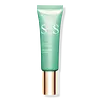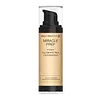What's inside
What's inside
 Key Ingredients
Key Ingredients

 Benefits
Benefits

 Concerns
Concerns

 Ingredients Side-by-side
Ingredients Side-by-side

Water
Skin ConditioningDimethicone
EmollientButylene Glycol
HumectantGlycerin
HumectantPhenyl Trimethicone
Skin ConditioningVinyl Dimethicone/Methicone Silsesquioxane Crosspolymer
CI 77891
Cosmetic ColorantAlcohol
AntimicrobialPEG/PPG-18/18 Dimethicone
EmulsifyingC12-15 Alkyl Benzoate
AntimicrobialSodium Chloride
MaskingSilica
AbrasiveSynthetic Fluorphlogopite
Bisabolol
MaskingParfum
MaskingEthylhexylglycerin
Skin ConditioningDisodium EDTA
Stearalkonium Hectorite
Gel FormingPropylene Carbonate
SolventAluminum Hydroxide
EmollientCI 77492
Cosmetic ColorantCI 42090
Cosmetic ColorantHexyl Cinnamal
PerfumingBenzyl Benzoate
AntimicrobialSodium Lauroyl Glutamate
Butylphenyl Methylpropional
PerfumingPhenoxyethanol
PreservativeLysine
Skin ConditioningAlpha-Isomethyl Ionone
PerfumingMagnesium Chloride
Furcellaria Lumbricalis Extract
Skin ConditioningPancratium Maritimum Extract
BleachingLinalool
PerfumingCitronellol
PerfumingLimonene
PerfumingEugenol
PerfumingCamellia Sinensis Leaf Extract
AntimicrobialTriethoxycaprylylsilane
Lapsana Communis Flower/Leaf/Stem Extract
Skin ConditioningMaris Sal
Skin ConditioningWater, Dimethicone, Butylene Glycol, Glycerin, Phenyl Trimethicone, Vinyl Dimethicone/Methicone Silsesquioxane Crosspolymer, CI 77891, Alcohol, PEG/PPG-18/18 Dimethicone, C12-15 Alkyl Benzoate, Sodium Chloride, Silica, Synthetic Fluorphlogopite, Bisabolol, Parfum, Ethylhexylglycerin, Disodium EDTA, Stearalkonium Hectorite, Propylene Carbonate, Aluminum Hydroxide, CI 77492, CI 42090, Hexyl Cinnamal, Benzyl Benzoate, Sodium Lauroyl Glutamate, Butylphenyl Methylpropional, Phenoxyethanol, Lysine, Alpha-Isomethyl Ionone, Magnesium Chloride, Furcellaria Lumbricalis Extract, Pancratium Maritimum Extract, Linalool, Citronellol, Limonene, Eugenol, Camellia Sinensis Leaf Extract, Triethoxycaprylylsilane, Lapsana Communis Flower/Leaf/Stem Extract, Maris Sal
Cyclopentasiloxane
EmollientWater
Skin ConditioningGlycerin
HumectantDimethicone Crosspolymer
Emulsion StabilisingSodium Chloride
MaskingTitanium Dioxide
Cosmetic ColorantAcetyl Glucosamine
Skin ConditioningDiethylhexyl Carbonate
EmollientNiacinamide
SmoothingEthylhexyl Methoxycinnamate
UV AbsorberPEG/PPG-18/18 Dimethicone
EmulsifyingAllantoin
Skin ConditioningAluminum Hydroxide
EmollientBenzyl Alcohol
PerfumingBHT
AntioxidantCamellia Sinensis Leaf Extract
AntimicrobialCaramel
Cosmetic ColorantDimethicone
EmollientDimethicone/Methicone Copolymer
Disodium EDTA
Ethylparaben
PreservativeMethylparaben
PreservativeCyclopentasiloxane, Water, Glycerin, Dimethicone Crosspolymer, Sodium Chloride, Titanium Dioxide, Acetyl Glucosamine, Diethylhexyl Carbonate, Niacinamide, Ethylhexyl Methoxycinnamate, PEG/PPG-18/18 Dimethicone, Allantoin, Aluminum Hydroxide, Benzyl Alcohol, BHT, Camellia Sinensis Leaf Extract, Caramel, Dimethicone, Dimethicone/Methicone Copolymer, Disodium EDTA, Ethylparaben, Methylparaben
Ingredients Explained
These ingredients are found in both products.
Ingredients higher up in an ingredient list are typically present in a larger amount.
Aluminum Hydroxide is a form of aluminum. It can be naturally found in nature as the mineral gibbsite. In cosmetics, Aluminum Hydroxide is used as a colorant, pH adjuster, and absorbent.
As a colorant, Aluminum Hydroxide may add opacity, or reduce the transparency. Aluminum hydroxide is contains both basic and acidic properties.
According to manufacturers, this ingredient is an emollient and humectant. This means it helps hydrate the skin.
In medicine, this ingredient is used to help relieve heartburn and help heal ulcers.
There is currently no credible scientific evidence linking aluminum hydroxide in cosmetics to increased cancer risk.
Major health organizations allow the use of aluminum hydroxide in personal care products and have not flagged it as a carcinogenic risk at typical usage levels.
Learn more about Aluminum HydroxideCamellia Sinensis Leaf Extract is derived from the leaves of the tea plant. Black tea, green tea, and oolong tea are all harvested from this plant.
This ingredient has many skin benefits:
This ingredient contains polyphenols, a strong antioxidant. Antioxidants help fight off molecules that damage skin cells.
On top of that, the antioxidants in green tea neutralize free-radicals from the sun. This gives the skin some extra UV protection, but should not replace sunscreen.
Many components of tea have anti-inflammatory properties.
Polyphenols and L-theanine help soothe the skin and reduce irritation. The caffeine in Camellia Sinensis Leaf Extract helps calm inflamed blood vessels.
Other compounds found in tea include: Vitamin Bs, linoleic acid, magnesium, calcium, iron, and zinc.
Research has shown both drinking Camellia Sinensis Leaf Tea and applying it to the skin can help boost skin elasticity and hydration. Studies also show using tea extract may reduce sebum, or oil, production.
Learn more about Camellia Sinensis Leaf ExtractDimethicone is a type of synthetic silicone created from natural materials such as quartz.
What it does:
Dimethicone comes in different viscosities:
Depending on the viscosity, dimethicone has different properties.
Ingredients lists don't always show which type is used, so we recommend reaching out to the brand if you have questions about the viscosity.
This ingredient is unlikely to cause irritation because it does not get absorbed into skin. However, people with silicone allergies should be careful about using this ingredient.
Note: Dimethicone may contribute to pilling. This is because it is not oil or water soluble, so pilling may occur when layered with products. When mixed with heavy oils in a formula, the outcome is also quite greasy.
Learn more about DimethiconeDisodium EDTA plays a role in making products more stable by aiding other preservatives.
It is a chelating agent, meaning it neutralizes metal ions that may be found in a product.
Disodium EDTA is a salt of edetic acid and is found to be safe in cosmetic ingredients.
Learn more about Disodium EDTAGlycerin is already naturally found in your skin. It helps moisturize and protect your skin.
A study from 2016 found glycerin to be more effective as a humectant than AHAs and hyaluronic acid.
As a humectant, it helps the skin stay hydrated by pulling moisture to your skin. The low molecular weight of glycerin allows it to pull moisture into the deeper layers of your skin.
Hydrated skin improves your skin barrier; Your skin barrier helps protect against irritants and bacteria.
Glycerin has also been found to have antimicrobial and antiviral properties. Due to these properties, glycerin is often used in wound and burn treatments.
In cosmetics, glycerin is usually derived from plants such as soybean or palm. However, it can also be sourced from animals, such as tallow or animal fat.
This ingredient is organic, colorless, odorless, and non-toxic.
Glycerin is the name for this ingredient in American English. British English uses Glycerol/Glycerine.
Learn more about GlycerinPEG/PPG-18/18 Dimethicone is a type of silicone.
Chances are, you eat sodium chloride every day. Sodium Chloride is also known as table salt.
This ingredient has many purposes in skincare: thickener, emulsifier, and exfoliator.
You'll most likely find this ingredient in cleansers where it is used to create a gel-like texture. As an emulsifier, it also prevents ingredients from separating.
There is much debate on whether this ingredient is comedogenic. The short answer - comedogenic ratings don't tell the whole story. Learn more about comegodenic ratings here.
The concensus about this ingredient causing acne seems to be divided. Research is needed to understand if this ingredient does cause acne.
Scrubs may use salt as the primary exfoliating ingredient.
Learn more about Sodium ChlorideWater. It's the most common cosmetic ingredient of all. You'll usually see it at the top of ingredient lists, meaning that it makes up the largest part of the product.
So why is it so popular? Water most often acts as a solvent - this means that it helps dissolve other ingredients into the formulation.
You'll also recognize water as that liquid we all need to stay alive. If you see this, drink a glass of water. Stay hydrated!
Learn more about Water